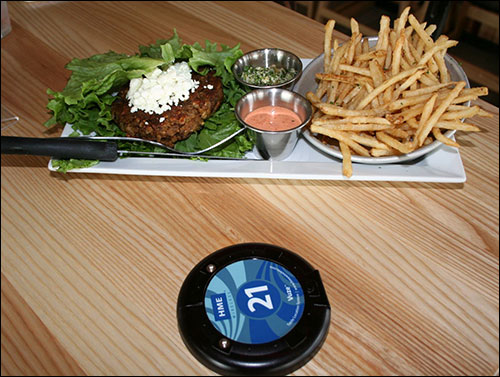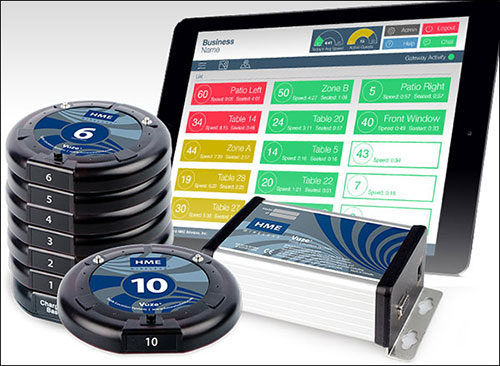Mar 09, 2015Several thousand fast casual restaurants around the world have installed, or are installing, an RFID solution provided by paging technology firm HME Wireless, a subsidiary of HM Electronics, to manage the serving of food to customers. Fast casual restaurants are a growing segment in the restaurant industry. These independent and chain eateries are set up to take food and drink orders from customers at the counter, after which the diners find themselves a table and a runner delivers their order to them once it comes out of the kitchen. HME Wireless' Vuze Table Location System is designed not only to help food runners locate the correct table for an order in real time, but also to enable restaurants to collect analytic data regarding how long it takes for guests to find tables and receive their food, and for an employee to return to the counter after making a delivery.
The challenge for many fast casual restaurants is getting the food to the proper diners efficiently. At most venues, guests carry a card printed with a number to their table, and are expected to display that card prominently so that food runners can spot the number and deliver the food quickly. For larger restaurants, however, containing dozens of tables, often within multiple rooms—and even outdoor seating, such as patios—this is not a quick process. If a runner is unable to find the number associated with a particular order, he or she must stop at tables and ask customers about their order until locating the correct recipients. By that time, the food may have either cooled or warmed toward room temperature.
In 2010, the staff at HME Wireless began working to create a paging solution to help diners receive their food more efficiently, according to Russ Ford, HME Wireless' VP of sales. However, he says, they realized such a system would not help runners locate a specific guest's table and deliver food any faster.
Ford says he began studying how the health-care sector uses RFID-based real-time location system (RTLS) technologies, and the company decided to design its own RTLS solution for use in restaurants. The resulting system, commercially released two years ago, features battery-powered 915 MHz (or, optionally, another frequency) RFID tags employing a proprietary air-interface protocol that HME Wireless developed to enable each tag to not only transmit its own unique ID number, but also receive the IDs of other nearby tags. There are two main types of Vuze tags: guest tags, which a restaurant provides to its customers, and reference tags, which are mounted to the undersides of tables within the dining area. The Vuze solution also includes an RFID gateway reader to collect transmissions from all tags and forward that information to the system's software. The transponders and gateway are custom-produced for the Vuze system.
HME's Vuze Table Location System software can reside locally as a standalone solution, or be hosted on a cloud-based server. A hybrid solution consists of software that locally stores RFID data , but also forwards that information to the cloud server at preset intervals.
When a customer arrives at a restaurant, he or she first places and pays for an order at the counter. The counter worker then takes a guest tag and inputs the number printed on that tag into the point-of-sale software, which forwards the order data to a video screen in the kitchen.
"When the diner takes the tag and walks into the dining room," Ford says, "the active RFID sequence begins." The tag emits a signal at preset intervals. In response, any reference tags within range transmit signals to the guest tag, which collects those responses and sends them to the gateway reader in a single batch. The software thereby determines that the diner who has placed that order is now looking for a table.
Upon sitting down, the customer places the guest tag on the selected table, and the tag forwards the ID numbers and signal strength of nearby reference tags. The Vuze software then uses that data to determine the specific table at which that customer is seated.
When a food runner searches for the table, he or she first looks up the order on the kitchen screen or a computer screen, which displays the tag number associated with that order. The software also displays the location of the table linked to the customer who placed the order. The runner then brings the prepared food to that table and picks up the guest tag, at which time the tag's transmissions indicate to the software that it has now been removed and the order has been delivered. Finally, the runner passes a deactivator tag while walking back to the kitchen, where he or she returns the tag for re-use. Thanks to the deactivator tag, the software now has a time stamp indicating when the runner returned from the table.
This data can help restaurant managers determine a business' efficiency. For instance, they can view if diners take too long to find tables, if they spend too much time waiting for their food or if a staff member is too slow in returning to the kitchen for the next order.
However, Ford notes, the technology's primary purpose is to help restaurants ensure that food is delivered to tables quickly. This, he explains, can ultimately lead to faster throughput of meals, enabling the serving of more customers. In addition, Ford says, it improves customer satisfaction levels if food is served quickly, and is still hot and fresh from the kitchen—and employees waste less time walking around dining rooms searching for tables.

Grub Burger Bar, which operates restaurants in Texas, Louisiana, Florida, Georgia and Pennsylvania, has been installing the technology with each new franchise it opens, says Bowen Eason, Grub Burger Bar's director of operations. "Customers love and expect modern technology these days, and appreciate the fact that their food comes to them promptly," he states. "We have actually gone back and retrofitted our existing locations as well. We are able to more efficiently deliver the customers' food to them. They get hotter burgers and fries, and colder salads."
In the two years since the Vuze Table solution was released commercially, Ford says, orders have been increasing exponentially. Based on the growing demand for Vuze, he adds, "we could see as many as 700 locations installed in Australia this year." What's more, he reports, the company expects to take the system live at 2,000 restaurants by the end of this year, throughout approximately 25 countries.
According to Ford, the company opted for the active RFID technology rather than passive because it did not require personnel to bring a reader within close range of a tag in order to read it.



